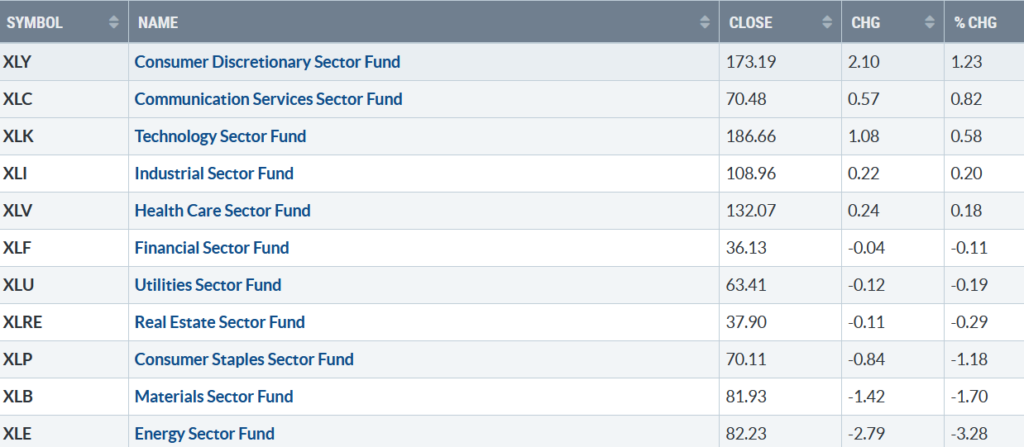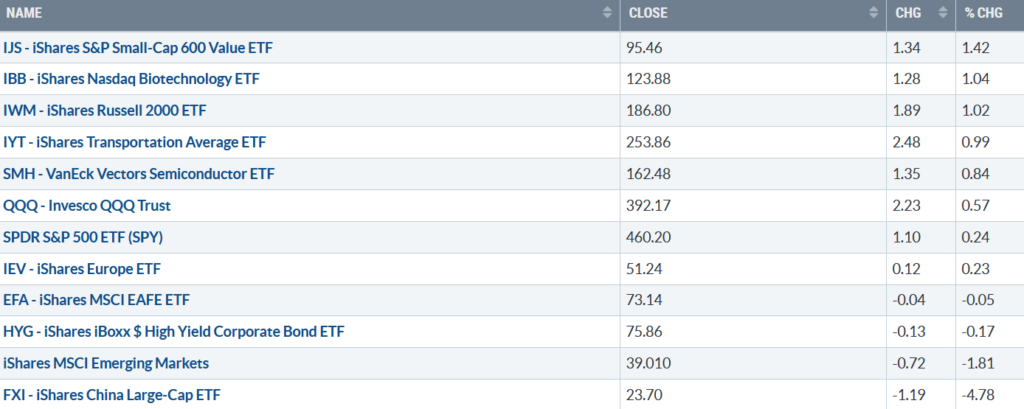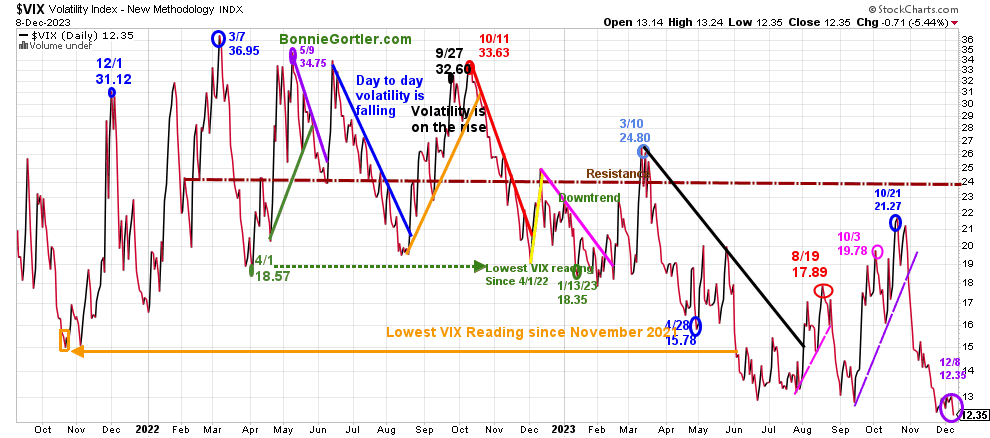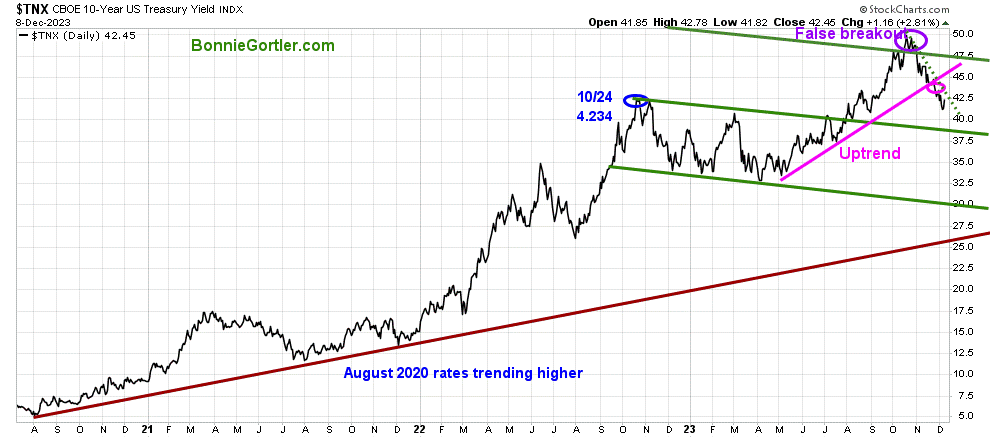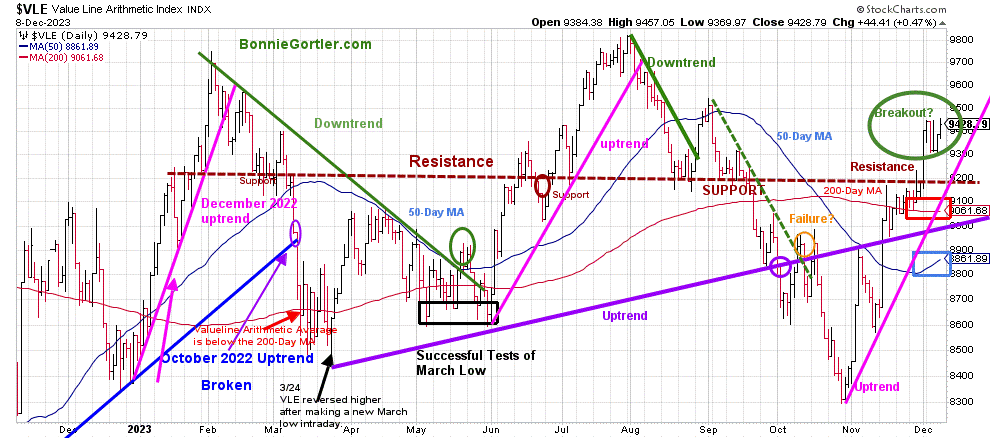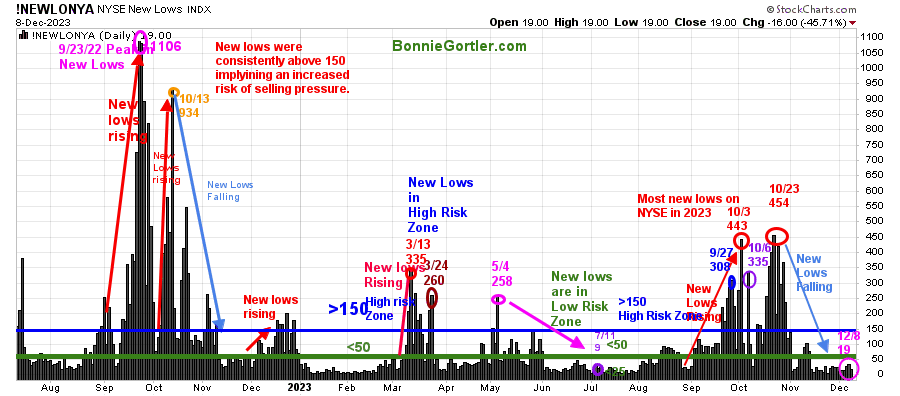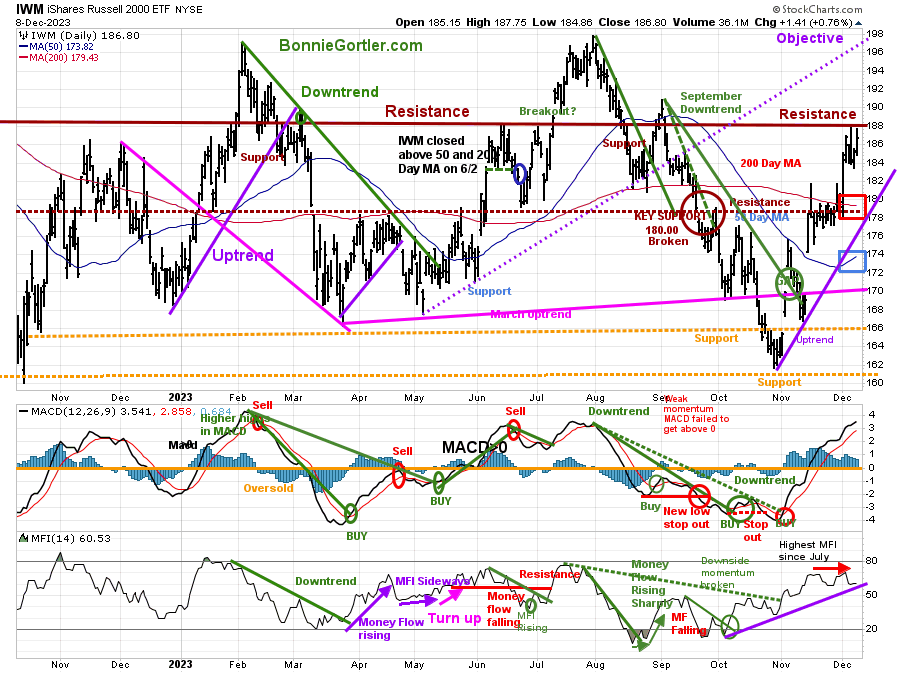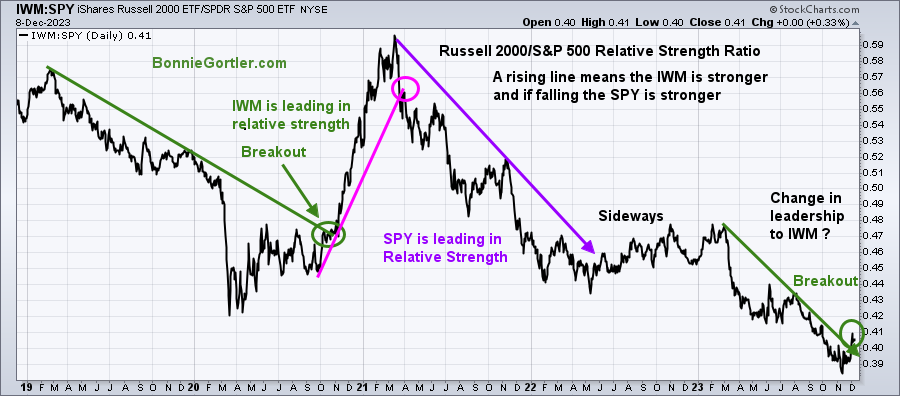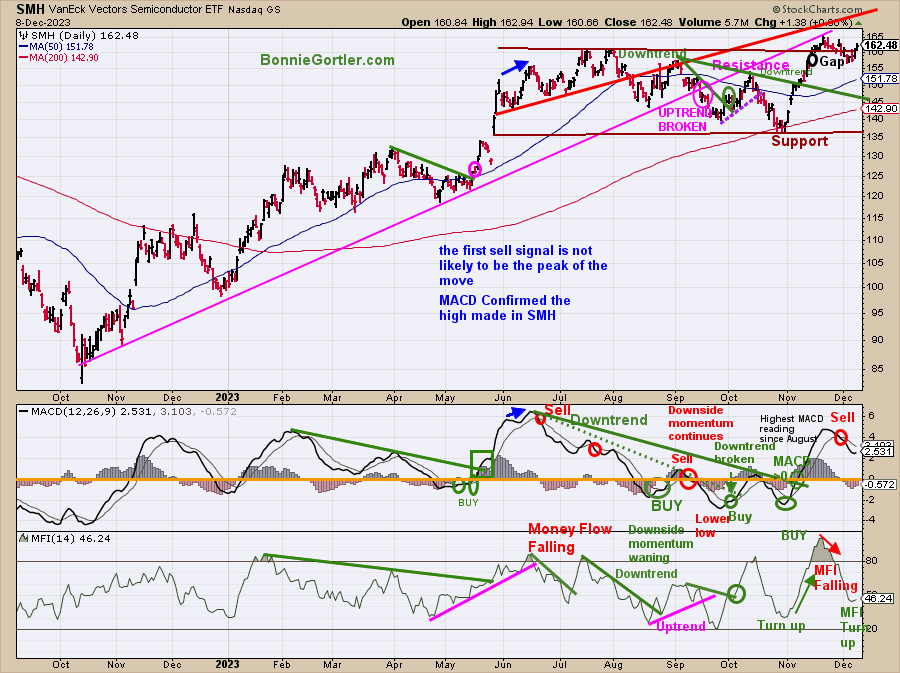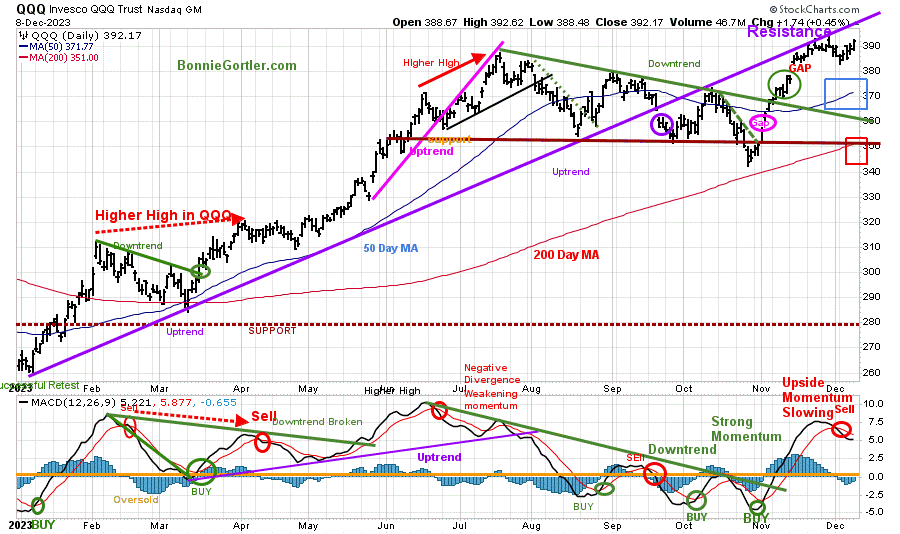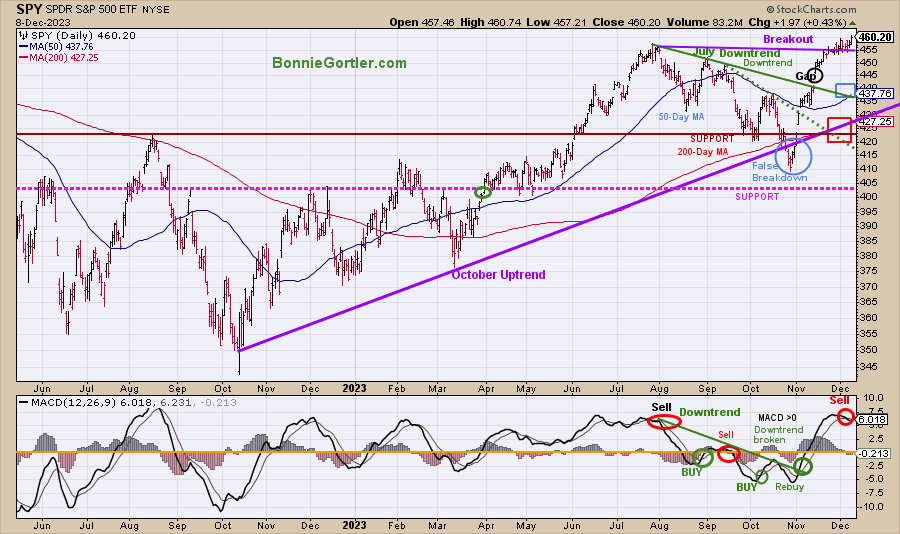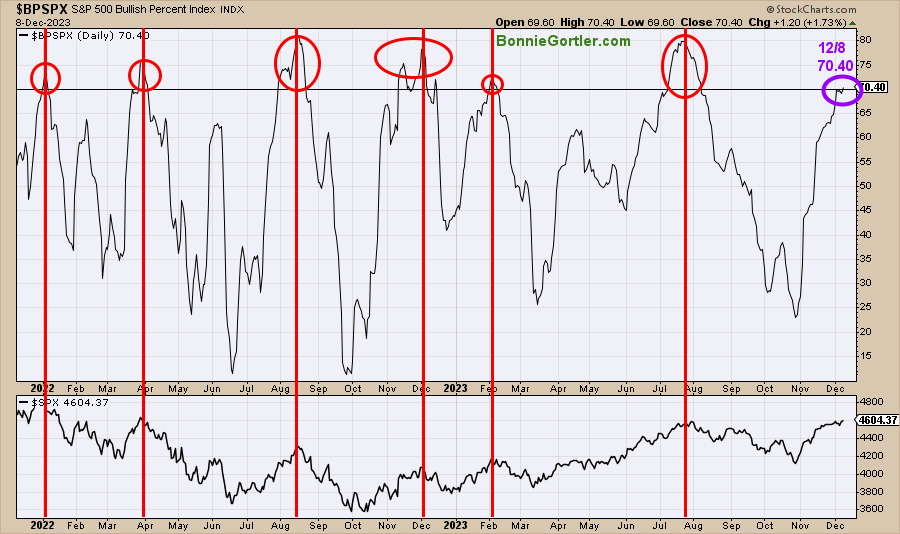The uptrend continued. Five of eleven S&P SPDR sectors were higher last week. Consumer Discretionary (XLY) and Communications Services (XLC) were the best sectors, while Materials (XLB) and Energy (XLE) were lower. The SPDR S&P 500 ETF Trust (SPY) gained +0.24%.
S&P SPDR Sector ETFs Performance Summary 12/01/23 – 12/08/23
Source: Stockcharts.com
Figure 2: Bonnie’s ETFs Watch List Performance Summary 12/01/23 – 12/08/23
Source: Stockcharts.com
Small Cap Growth, Small Value, Biotechnology, and Transportation led the way along with Semiconductor and Technology stocks, which have led the advance but have slowed their gains. China remains out of favor.
Figure 3: CBOE Volatility Index VIX
Source: Stockcharts.com
The CBOE Volatility Index (VIX), a measure of fear, traded above 20.00 for most of 2022, with a high at 36.95 on 3/7 (blue circle), which did not get violated in 2023.
VIX closed slightly lower at 12.35 (purple circle) last week, the lowest close of the year.
If the VIX remains below 16, intraday volatility will be limited.
Figure 4: UST 10YR Bond Yields Daily
Source: Stockcharts.com
The 10-year U.S. Treasury yields rose last week, closing at 4.245%, trending down and remaining below the May uptrend (pink line) and the downtrend from October after the false break out.
Support remains at 3.90%. Falling yields will continue to be short-term positive for equities. A quick rise in yields would be short-term negative.
The major market averages eked out gains for the week, with the Dow up + 0.01%, S&P 500 +0.21%, up for the sixth straight week, while the Nasdaq gained +0.69%. The Russell 2000 Index led the advance, gaining +0.98%.
Are you interested in learning about the stock market? Learn how to implement a powerful wealth-building mindset and simple, reliable strategies to help you grow your wealth in my eCourse Wealth Through Investing Made Simple in the comfort of your home. Learn more here.
Figure 5: Value Line Arithmetic Average
Source: Stockcharts.com
The Value Line Arithmetic Index ($VLE) is a mix of approximately 1700 stocks. VLE broke the October 2022 uptrend in early March 2023 (blue line), and April, May, and June successfully tested the March low and ultimately made a new low in October 2023.
The daily trend of VLE is up. VLE closed slightly higher last week at 9428.79, up +0.29%, remaining above resistance. VLE remains above the 50-day MA, which is rising now (blue rectangle), and the 200-day MA (red rectangle), a sign of underlying strength.
Support remains 9200, 9000, 8800, and 8600. Resistance is at 9500, 9700, and 9800.
It is bullish that VLE shows strength, closing above 9200 resistance and in an uptrend.
Do you want to go deeper into charting? Learn more in the comfort of your home today with my Free 33-minute Training, Charting Strategies to Cut Risk and Trade with the Trend. Sign up here.
Uninspiring breadth
Weekly market breadth was mixed on the New York Stock Exchange Index (NYSE) and for the Nasdaq. The NYSE had 1428 advances and 1533 declines, with 294 new highs and 68 new lows. There were 2455 advances and 2253 declines on the Nasdaq, with 355 new highs and 304 new lows.
The NYSE and Nasdaq need positive market breadth for the rally to continue.
If you want to go more in-depth with charts, I invite you to join my Free FB group, Wealth Through Market Charts.
Figure 6: Daily New York Stock Exchange (NYSE) New Lows
Source: Stockcharts.com
Watching New Lows on the New York Stock Exchange is a simple technical tool that helps awareness of the immediate trend’s direction. New lows warned of a potential sharp pullback, high volatility, and “panic selling” for most of 2022, closing above 150. The peak reading was 9/23/22 when New Lows made a new high of 1106 (pink circle), and New Lows expanded to their highest level in 2023 on 3/13/23 (red circle) to 335.
New Lows increased in September (red arrow on the right) toward the high-risk zone greater than 150, peaking at 443 on 10/3, the highest reading since October 2022.
New lows had stopped accelerating in early October. However, the decline was not complete until the end of the month as New Lows made only a slight new high, peaking at 454 (red circle) on 10/23.
New lows on the NYSE closed at 19 (pink circle), only slightly higher than last week, remaining in the lowest risk zone below 25. It would remain positive and imply low risk if New Lows stay between 25 and 50. On the other hand, an increase above 150 would be a warning sign of a market correction.
Learn more about the significance of New Lows in my book, Journey to Wealth, published on Amazon. If you would like a preview, get a free chapter here.
Figure 7: Daily iShares Russell 2000 (IWM) Price (Top) and 12-26-9 MACD (Middle and Money Flow (Bottom)
Source: Stockcharts.com
The top chart is the daily iShares Russell 2000 Index ETF (IWM), the benchmark for small-cap stocks, with a 50-Day Moving Average (MA) (blue line) and 200-Day Moving Average (MA) (red line) that traders watch and use to define trends.
IWM closed at 186.80, up +1.02% last week, closing below resistance at 188.00, but remains above the 50-day MA and above the 200-day MA (blue rectangle).
Support remains at 178.00, 170.00, 166.00, and 161.00. Resistance is at 188.00 and 197.00.
MACD (middle chart) remains on a buy, above 0, and rising. After a few whipsaws, MACD has shown continued strength since breaking the August downtrend, but notice how each pulse is getting weaker.
Money Flow (lower chart) appears to have peaked after reaching its highest level since July. The uptrend remains (purple line) for now but could break this week, which would be negative.
Keep an eye on the Russell 2000 (IWM) for a clue for this week’s direction. It would be positive if IWM remains stronger than the S&P 500. However, if IWM lags, it would be a clue that a retracement towards 178.00 and the breakout in relative strength is false.
Figure 8: Relative Strength Ratio Russell 2000 vs. S&P 500 (IWM)/S&P500 (SPY)
The chart is the Daily Relative Strength Ratio Russell 2000 vs. S&P 500 (IWM)/S&P500 (SPY). A rising line means the Russell 2000 (IWM) is stronger, and if falling, the S&P 500 (SPY) is stronger.
Notice that IWM has broken the downtrend from February 2023, a positive sign for a change in leadership to small-cap stocks.
If IWM outperforms the S&P 500 (SPY) and closes above 188.00 resistance for two days, the odds favor that money will flow into IWM and will outperform the S&P 500 in the near term.
For the latest Bonnie’s charts, visit https://www.bonniegortler.com/marketcharts/
Figure 9: Daily Semiconductors (SMH) (Top) and 12-26-9 MACD (Middle) and Money Flow (Bottom)
Source: Stockcharts.com
The top chart shows the Daily Semiconductors (SMH) ETF, concentrated mainly in US-based Mega-Cap Semiconductors companies. SMH tends to be a lead indicator for the market when investors are willing to take on increased risk and the opposite when the market is falling.
The Semiconductor ETF (SMH) gained +0.84% last week, closing at 162.48 after consolidating over the past few weeks.
Support remains at 155.00, 151.00, 145.00 and 137.00. Resistance is at 168.00. The Short-term objective remains 185.00.
MACD (middle chart) is on a sell, falling after reaching its highest MACD reading since August.
Money Flow (lower chart) fell after reaching the highest level in 2023 and turned slightly higher last week, but it is not convincing to say money is moving into SMH. The price of gains is likely to slow in Semiconductors after their strong performance this year.
Figure 10: Daily Invesco QQQ Trust (QQQ) Price (Top) and 12-26-9 MACD (Bottom)
Source: Stockcharts.com
The chart shows the daily Invesco QQQ, an exchange-traded fund based on the Nasdaq 100 Index. QQQ made a low in October 2022 (red circle), followed by a successful retest of the low in early January 2023 and the start of an uptrend.
QQQ broke the July downtrend (green line) and continued sharply higher.
Last week, the Nasdaq 100 (QQQ) was little changed, up +0.57%, closing at 392.17. QQQ remains above the 50-day Moving Average (blue rectangle) and the 200-day Moving Average (red rectangle), a sign of underlying strength.
Support is 380.00, 376.00, 368.00, 360.00, and 350.00, with resistance at 394.00.
The bottom chart, MACD (12, 26, 9), is on a sell, above 0, falling, with the upside momentum slowing after reaching its highest reading since July.
It is bullish that the gap (pink circle) remains, not filled from three weeks ago. However, with MACD momentum slowing and resistance slightly above, after significant gains in November, be alert to profit-taking if QQQ does not get above 394.00 and closes below 380.00 for two days.
Figure 11: The S&P 500 Index (SPY) Daily (Top) and 12-26-9 MACD (Bottom)
Source: Stockcharts.com
The S&P 500 (SPY) had a false breakdown (blue circle) in October after being in an uptrend (purple line). Two downtrends were in effect and broken to the upside in September (green dotted line) and August (green solid line).
The daily trend remains up. SPY continued higher, closing at 460.20, up +0.24% for the week, remaining above the 50-day Moving Average (blue rectangle) and the 200-day Moving Average (red rectangle), a sign of strength.
Support is at 455.00, 445.00, 437.00, 425.00, and 405.00. SPY remains above 455.00, where it broke out (purple horizontal line). Time will tell if the breakout is real or more consolidation is needed.
MACD (bottom chart) generated a sell last week.
A higher objective of 485.00 remains for the SPY 485.00. It would be positive if SPY closed above 460.00 on Monday and stayed above last week’s low of 454.34. With momentum diminishing, the risk is increasing of a consolidation of the recent gains and profit taking into the end of the year.
Figure 12: S&P 500 Bullish Percent Index
Source: Stockcharts.com
The Bullish Percent Index (BPI), developed by Abe Cohen in the 1950s, is a breadth indicator based on the number of stocks based on Point and Figure Buy signals. The indicator helps you know the market’s health and when it’s overbought or oversold.
When the bullish percent index is above 70%, the market is overbought, and when the indicator is below 30%, the market is oversold. Like other overbought indicators, sometimes it does not get as high or as low.
In 2022 and 2023, the indicator reached 70 (overbought) six times (red circles). All occurrences were near market peaks (red lines). Last week, the BPI closed at 70.40 (purple circle). A reading over 70, followed by a retracement below 70, would give a sell signal on this indicator.
Summing Up:
The trend remains up, with the Nasdaq and S&P 500 up for the sixth consecutive week. The market internals are weakening, with daily momentum oscillators generating sell signals, implying the risk of a potential pullback is increasing. Investor sentiment no longer shows fear as it did one month ago, now showing greed (a contrary indicator). Review your portfolio and have an exit strategy to prepare for a potential pullback if the rally stalls. You never go broke, locking in a profit.
Remember to manage your risk, and your wealth will grow.
Let’s talk investing. You are invited to set up your Free 30-minute Wealth and Well-Being Strategy session by clicking here or emailing me at Bonnie@BonnieGortler.com. I would love to schedule a call and connect with you.
Disclaimer: Although the information is made with a sincere effort for accuracy, it is not guaranteed that the information provided is a statement of fact. Nor can we guarantee the results of following any of the recommendations made herein. Readers are encouraged to meet with their own advisors to consider the suitability of investments for their own particular situations and for determination of their own risk levels. Past performance does not guarantee any future results.


